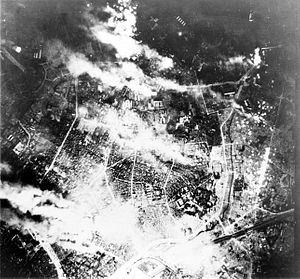On the night of March 10, 1945, the U.S. Army Air Force conducted the most destructive attack in the history of human warfare. 279 B-29 Superfortresses dropped their bombs over their target, killing up to 100,000 Japanese civilians. The attack surpassed in lethality either of the atomic bomb attacks later in 1945. The firestorm incinerated much of one of the world’s largest cities, leaving nearly million people homeless. Fourteen B-29s were shot down.
A new book from Osprey is helping to offer new perspective on the fire raid on Tokyo. In Japan 1944-45, Mark Lardas paints a new and devastating picture of what the attack looked like from the air, and from the ground. Lardas challenges common misperceptions about the raid, which have tended to frame it in terms of the Combined Bomber Offensive against Germany. The experience of the attack was fundamentally different, in the air and on the ground, from what happened in Germany and what had happened in Japan to that point. Moreover, it was different than later attacks against other Japanese cities.
The raid was the first major night attack against Japan, and the first raid using low altitude bombing tactics. The Americans anticipated that the Japanese would be unprepared for such tactics, and in any case believed that the fuel savings would enable to bombers to carry heavier loads and inflict much greater damage. Unlike in Europe, the B-29s did not need to fly in self-defending formations. Instead, they could fly in echelon, spaced out only by the requirements of runway space.
This meant that they arrived above Tokyo over the course of two hours, rather than as a single formation. And this meant that the fires that would destroy one of the world’s largest cities began slowly, piecemeal as individual bombers dropped their lethal load of incendiary bombs. The city started to burn slowly, and civil defense authorities did their best. But every few minutes a new bomber arrived, in a new part of the city, with a new load of incendiaries. As Lardas related, the spreading fires reduced visibility and began to endanger gun crews. Communications collapsed.
Japanese defenses were ineffective, even in Tokyo. Fuses were set for 30000’, the altitude the Japanese expected the B-29s to arrive at. Japan’s interceptors, barely a match for the Superfortresses in any case, were also at the wrong altitude. After three years of war, Japan’s military could not perform its most fundamental of tasks; preventing the destruction of its capitol city.
The Japanese populace learned from the experience. Later fire raids incinerated cities, but did not kill nearly as many people. Civilians and civil authorities learned that they could escape on foot to relatively underdeveloped areas. Much of Japan was still rendered homeless, but until the nuclear raids of August, the death rate declined dramatically.
The Tokyo Fire Raid is well-known among specialists, and new interpretation only serve to modify our understanding of the event, its effects, and its participants. But it is remarkable that the most destructive event in the history of human warfare, the incineration of much of one of the world’s greatest cities, was eclipsed in the popular imagination in just a few short months.
The views expressed here are his personal views and do not necessarily reflect those of the Department of Defense, the U.S. Army, the Army War College, or any other department or agency of the U.S. government.

































